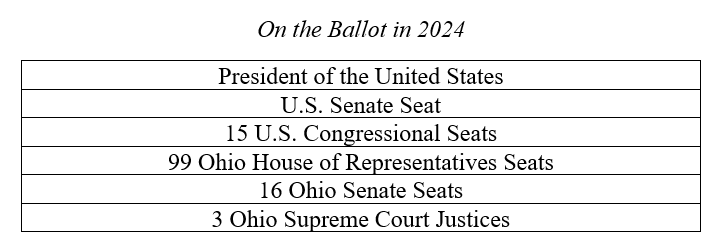by: Andy Jesson, AOF Policy & Communications Intern
On November 7, Ohio voters approved two statewide initiatives regarding abortion access and legalization of recreational marijuana. Issue One’s passage establishes a right to abortion within the state constitution, while Issue Two legalizes the purchase, possession and consumption of marijuana for adults over the age of 21. In Central Ohio, voters gave Columbus Mayor Andrew Ginther another term in office and approved levies for local schools and public libraries.
3.9 million Ohioans cast their ballots in the November 2023 election, representing a turnout of about 49 percent of registered voters. Considering trends in different election years, 49 percent turnout is significant for a non-presidential or midterm year. In the 2022 midterms, when Ohio voted on a U.S. Senate seat and eight statewide offices, 4.2 million Ohioans cast ballots.
The results of Tuesday’s election represent victories for abortion rights advocates and proponents of marijuana legalization, however; the path forward for each issue varies.
What’s Next for Issues One and Two
When Ohio voters approved Issue One on Tuesday, they approved an amendment to the Ohio Constitution, meaning despite opposition by many members in the state legislature, lawmakers are very limited in their authority to pass laws restricting access to abortion. Passage of Issue Two makes Ohio the 24th state in the country to legalize adult recreational cannabis use. Notably, Issue Two was not an amendment to the Ohio Constitution but rather a citizen initiative. Because of this distinction, lawmakers in Columbus now possess the authority to modify the law in the coming weeks. Issue Two is set to go into effect on December 7, 2023.
Ohio House Speaker Jason Stephens and Senate President Matt Huffman have both been outspoken opponents of Issue Two, but it remains unclear how the legislature will approach making changes to the law as it was written. Ohio law is not explicit in allowing or prohibiting the legislature from repealing a law approved by voters, though doing so would undoubtedly result in legal challenges. Legislators in Columbus from both political parties doubt this is a likely path forward. Attention now shifts to how the legislature chooses to change the law prior to its implementation.
Impact on 2024
Such high turnout for an off-year election suggests a positive trajectory in voter engagement for future elections. In 2020, Ohio ranked 27th in the nation in voter turnout rate, with significant room for improvement. 2023 turnout figures are an encouraging sign in efforts to increase voter participation.
With the 2024 presidential election less than a year away, the results of Tuesday’s election signify a divide between top-level elected officials in the state and some of the views held by citizens. Despite Republican victories in all statewide races in 2022, voters approved Issue One and Issue Two, initiatives opposed by Republican leaders. With important races including a U.S. Senate seat and candidates for president on the ballot next year, it will be noteworthy to watch how candidates opposed to abortion and recreational marijuana approach the topics, and how voters respond.



